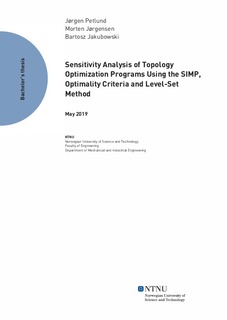| dc.contributor.advisor | Tyflopoulos, Evangelos | |
| dc.contributor.author | Petlund, Jørgen | |
| dc.contributor.author | Jørgensen, Morten | |
| dc.contributor.author | Jakubowski, Bartosz | |
| dc.date.accessioned | 2019-09-06T14:06:04Z | |
| dc.date.available | 2019-09-06T14:06:04Z | |
| dc.date.issued | 2019 | |
| dc.identifier.uri | http://hdl.handle.net/11250/2613430 | |
| dc.description.abstract | Denne oppgaven er skrevet som en introduksjon til topologioptimalisering, dets teori og metoder, og en sammenligning av fire programmer, to Open Source (TopOpt and OpenLSTO) og to kommersielt tilgjengelige (Abaqus and Ansys). Programmene er valg slik at de representerer de tre hovedtypene algoritmer brukt: SIMP, Optimality Criteria og Level Set Method. Alle disse vil være omtalt i mer detalj.
Måten programmene blir testet på, er ved å sette opp en enkel boks med 4x4x1 proporsjoner, med varierende fastsetninger og belastninger. Metodene og tilnærmingen som tas vil bli diskutert, og resultatene vil bli analysert i forhold til våre funn.
Teknologien som omtales her, er et tidlig innblikk i hvordan produksjonsprosessen til nesten alle viktige, bærende deler kan se ut i nær fremtid. Med tanke på nyeste fremskritt innen datavitenskap, topologioptimalisering og additivproduksjon, føles denne fremtiden veldig ekte, og vil kreve at ingeniører i det nevnte feltet tilpasser seg. | |
| dc.description.abstract | This thesis is written as an introduction to topology optimization with its theory and methods, as well as a comparison between four programs, two open source (TopOpt and OpenLSTO) and two commercially available ones (Abaqus and Ansys). The programs are chosen to represent the three mainly used algorithms there are: SIMP, Optimality Criteria and Level Set Method, all of which will be explained in more detail.
The way the programs capabilities will be tested is by setting up a simple box of 4x4x1 proportions with varying fixtures and loads. The methods and the approach taken will be discussed, and the results analyzed in the light of our findings.
The technology discussed is an early glimpse into what the manufacturing process may look like for nearly all crucial, load bearing parts in the near future. With the recent advances in computer science, topology optimization, and additive manufacturing, this future feels very real, and will require engineers in the mentioned field to adapt. | |
| dc.language | eng | |
| dc.publisher | NTNU | |
| dc.title | Sensitivitetsanalyse av Topologi Optimaliseringsprogrammer ved bruk av SIMP, Optimality Criteria og Level-Set Method | |
| dc.type | Bachelor thesis | |
